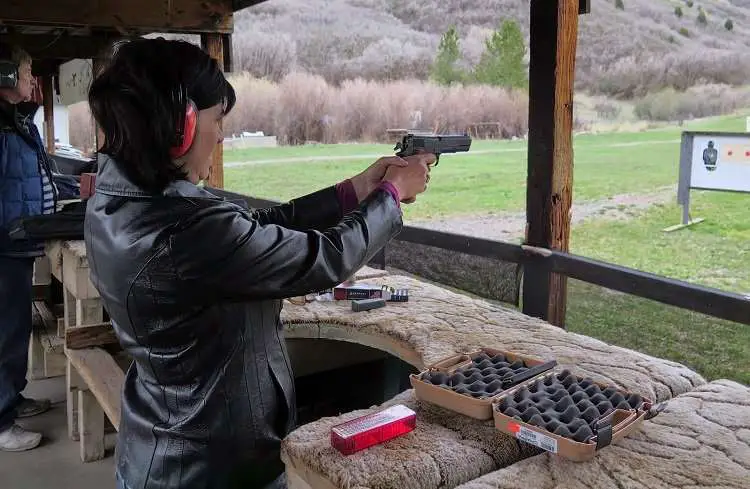
Introduction to Guns
There’s more to shooting than just owning a gun and pulling the trigger. In our ultimate guide to guns and shooting, we won’t only teach you the basics, but we’ll also show you how to be a smart shooter and a responsible gun owner. So let’s get right to it!
Shooting and Gun Lingo
Firearms are defined as “any weapon (including a starter gun) which will or is designed to or may readily be converted to expel a projectile by the action of an explosive,” by the Bureau of Alcohol, Tobacco, Firearms, and Explosives (ATF). “The frame or receiver of any such weapon, any firearm muffler or firearm silencer, or any destructive device” are also considered firearms. https://www.atf.gov/firearms/firearms-guides-importation-verification-firearms-ammunition-gun-control-act-definitions
Further reading: Firearm Statistics
Let’s learn the basic terms you’ll encounter and use often.
Ammunition – is what gets loaded into the firearm.
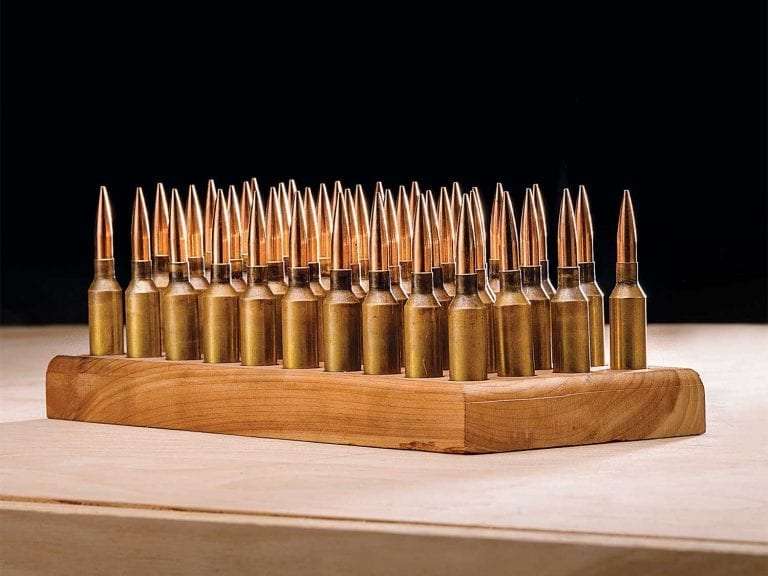
Ballistics – It is “the science of the travel of a projectile in flight. The flight path of a bullet includes: travel down the barrel, the path through the air, and path through a target.” (Fackler, 1996)
Looking for a reliable self-defense cartridge? Check out our comparison on the .380 vs 9mm and our picks for the best .380 ammo!
Blank – Blank is the term used for a cartridge without a bullet. They contain gunpowder so they still produce a tiny explosion at the end of the barrel. Blanks are usually used on prop guns.
Buckshot – Buckshots or buckshot pellets are ammunition used on shotguns and are often used for hunting large game.
Caliber – is the diameter of a bullet at its widest point. Calibers units are classified into Imperial (inches) and Metric (millimeters).
Cock – is the act of pulling and setting the gun’s hammer or firing mechanism against the spring tension prior to firing. (Further reading: Best Hammer-Fired Compact 9mm Pistol)
Discharge – is the act of firing a gun.
Firing Pin – is part of a gun’s firing mechanism and is responsible for striking the primer, which in turn ignites the propellant.
Fouling – is the carbon, lead, or copper buildup that accumulates in the barrel because of regular firing without proper gun cleaning.
Game – In hunting, this is the term used on animals that are hunted for their meat or fur.
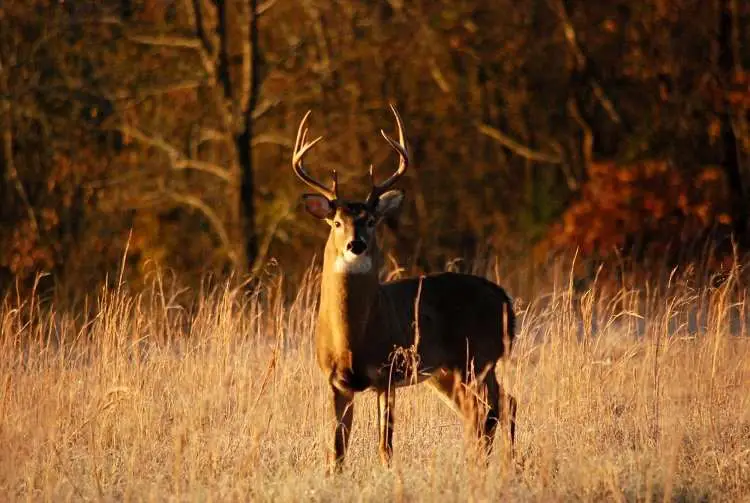
Grain – is the unit used to measure how much a bullet weighs.
Recoil – is the backward force that occurs every time the gun is fired.
Round – is another term for one unit of ammunition or a single cartridge.
Safety – is the part of the gun that restrains the trigger to prevent accidental firings.
Scope – is an accessory that helps in improving shooting accuracy by magnifying the target and aiding in faster target acquisition. Make sure you know how to mount a scope properly.
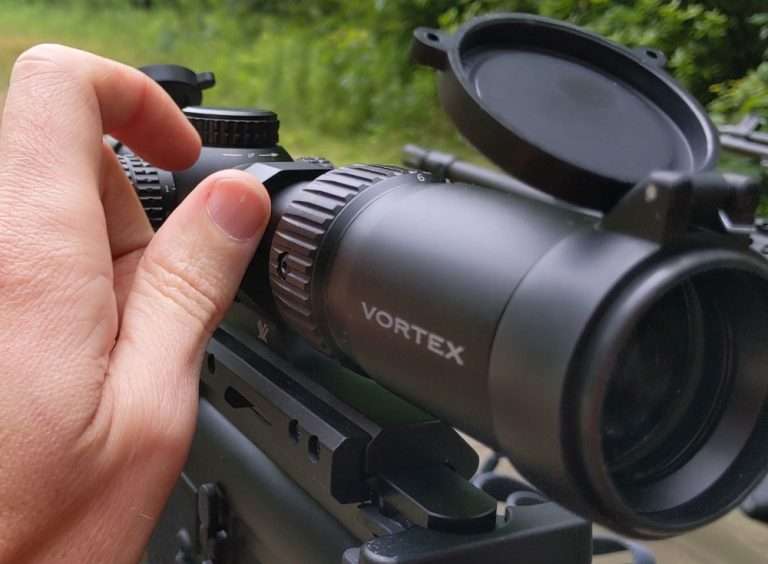
Trajectory – is the path traveled by the bullet from the gun’s muzzle to the target.
Zeroing in/sighting in – means to adjust your firearm so you can hit your target at the exact spot that you aim.
Guide to Guns and Shooting: How Guns Work
The main purpose of a gun is to fire a projectile at a high velocity so it can accurately hit a target at long distances.
Guns expel projectiles or bullets through the force created by a propellant. When the trigger is pulled, this propellant or gun powder is ignited by the explosive in the primer located at the other end of the shell.
Here’s a short video on how guns work.
Basic Parts of a Gun
To fully understand how guns work, you must be well-versed in the basic parts of a gun.
Barrel – The barrel is a long metal tube that guides the bullet out of the gun. Its length play a big role in a gun’s accuracy.
Barrels also undergo a process called barrel fluting for weight reduction.
If you have a new firearm, find out if you need to do barrel break-in from our latest article.
Grip – The grip is the part of a handgun or rifle (see best AR-15 pistol grip) where you wrap your hands around to shoot it.
Magazine – The magazine is a container that holds the ammo. It’s spring-operated and is either detachable or fixed.

Safety – The gun’s safety is a lever or button that can be turned on and off. When turned off, it stops the firing pin from hitting the primer so accidental firing is prevented.
Stock/Buttstock – The buttstock is only found in long guns and is at the back portion. It is used to provide structural support to the rifle or shotgun during firing. The best AR stock can make a huge difference in your rifle’s overall performance.
Trigger – The trigger is a mechanical switch that causes the gunpowder to burn explosively when pulled, initiating the firing process. In modern guns, it causes a hammer to drop and strike a firing pin, which then hits a shell primer, causing the explosion that launches the bullet.
Check out our Taurus G2C trigger upgrade review for a list of the best triggers today!
You can also enhance your trigger’s performance. Learn how to improve Mil-Spec AR15 Trigger in our extensive guide!
Trigger Guard – The trigger guard is the part of the gun surrounding the trigger and helps to prevent accidental firing.
Types of Firearms
Firearms are normally classified by their size, the type of barrel, the type of action, and how they are used. And, practically all types can be ordered online as long as you have a local FFL to assist with the pickup process.
Handguns
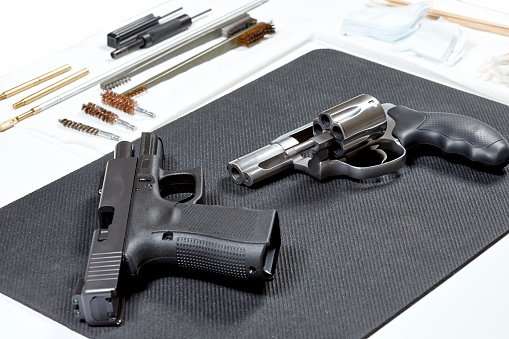
Handguns are small in size and can be held in one hand. They’re primarily used to shoot at targets up to 10 yards away. There are two types of handguns – pistols and revolvers. Some shooters prefer a pistol versus a revolver, and some like it the other way around. We’ll find out the difference in a bit.
We’ve got a whole article devoted just to the best handgun brands to cover the best manufacturers.
Pistols
Pistols are the most common type of handgun. The gun action types for pistols are single and dual-action with both semi-automatic and single-shot types. We’ll explain those in a bit.
In terms of magazine capacity, pistols are also divided into two types. Make sure you know the difference between single stack vs double stack pistols before making a purchase.
Wanna know a secret? We love the M1911 for shooting. Check out our favorite brands in this article – the best 1911 pistols.
If you prefer Glocks, you’ll love our Glock 22 vs 23 article!
Revolvers
The revolver is a handgun with a revolving multi-chambered cylinder block where the rounds get loaded into. This revolving block then feeds the bullet into alignment with the gun barrel. Revolvers come in single-action and double-action setups.
Curious about what’s the best handgun ever made? Click on the link to find out!
If you’re looking to buy your first gun, here are our recommendations for the best handguns for beginners.
Rifles
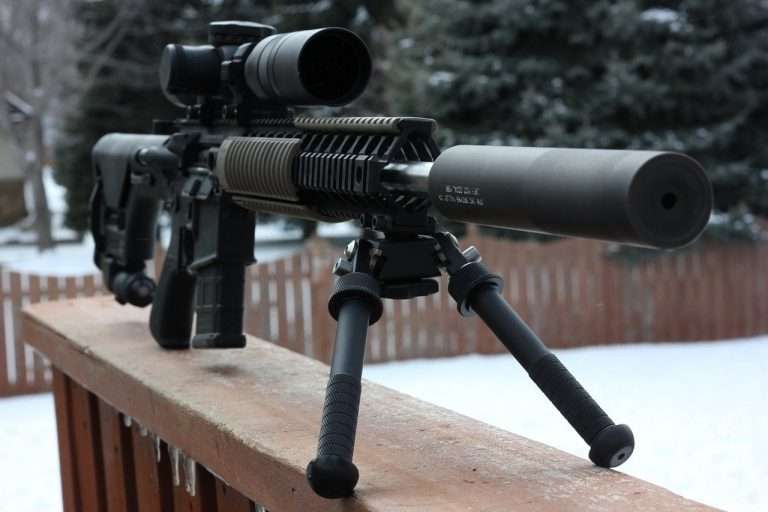
Rifles have long barrels and are held against the shoulder with both hands. They can shoot targets over 500 yards away.
Rifles have spiral cuts inside their barrel called rifling, hence the name. These grooves cause the bullet to spin as it travels down the barrel, giving it stability and better accuracy at extended ranges.
Building your AR-15 from the ground up? These articles should help:
If you’re looking for an air gun for terminating rodents in your backyard, check out our picks for the quietest air rifles.
Looking for an efficient but low-recoiling firearm? Check out the best 9mm carbine!
Here are some other resources for you:
- Best 30-06 Rifles
- Best 6.5 Creedmoor Rifles
- Best .300 Win Mag Rifles
- Best .338 Lapua Rifles
- Best Hammer-Fired Concealed Carry Pistol
- What Does AK Stand For?
- Guns used in Yellowstone
- Best Hammer-Fired Pistols
- Guns used by Army Rangers
- Guns used by 007
- Guns used by SEAL Team Six
- Guns used by the US Army
Shotguns
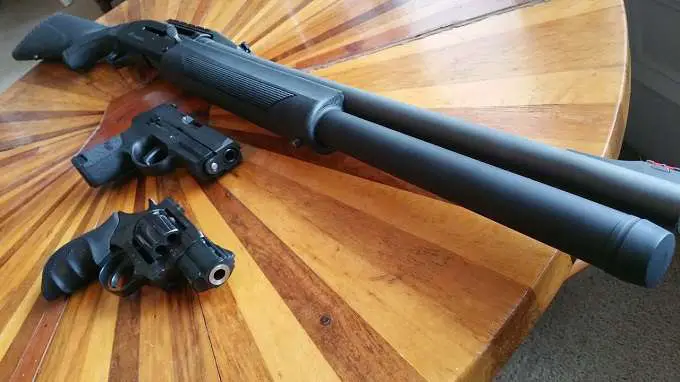
Shotguns also have long barrels and need to be held by both hands and can shoot targets that are up to 75 yards away depending on the shell used.
Shotguns shoot pellets instead of bullets in most applications. These pellets scatter upon firing, that’s why they’re also called scatterguns or pepper guns. They can also be used to fire slugs or sabots that may have rifling on the projectile itself.
Learn more about shotgun gauges and calibers in our comprehensive guide!
Ammo Fundamentals
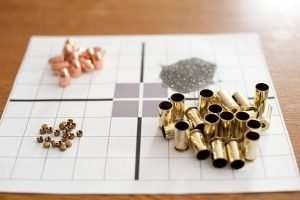
Cartridge – A cartridge is what a single round of ammunition is called. It has four parts – cartridge case, primer, propellant, and bullet.
Cartridge Case – The cartridge case houses and holds all the gun parts together.
Bullet – The bullet is the projectile that gets fired out of the gun and into the target.
Propellant – The propellant or gunpowder is the explosive part of a cartridge.
Primer – The primer serves as a spark plug that ignites the propellant to expel the bullet.
Ammo Caliber Comparisons
Want to learn more about which caliber would be a good fit for your next firearm? We’ve got guides to all of the most popular calibers for handguns, rifles, even air guns.
Gun Safety
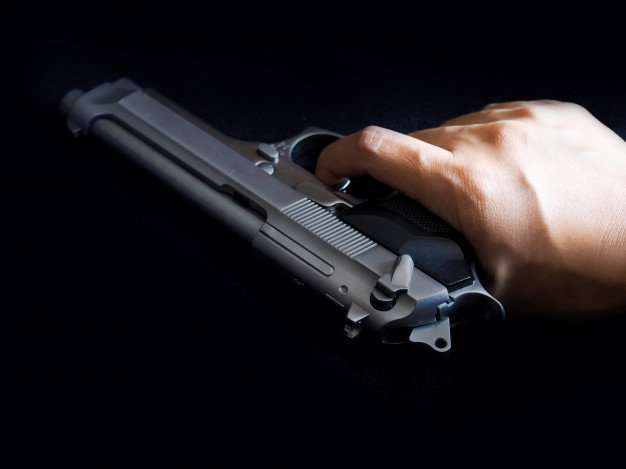
Owning a gun comes with a responsibility, not only for your sake but also for the people around you. There are 4 primary rules of gun safety:
- Treat every gun as if it is loaded.
- Never point a gun at anything you are not willing to destroy
- Keep your finger off of the trigger until you are ready to shoot
- Be sure of your target and what’s behind it
Some advocate for additional rules once you’ve mastered those:
- Store your gun in a safe place when not in use
- Use the right ammunition
How to Shoot Well
Now we’re done with the basics, congratulations on making it this far! Because here comes the exciting part – learning how to shoot well!
If you love action movies, you can also acquire some shooting and gun-handling knowledge from them. Just like how we learned self-defense lessons from John Wick.
Shooting Fundamentals
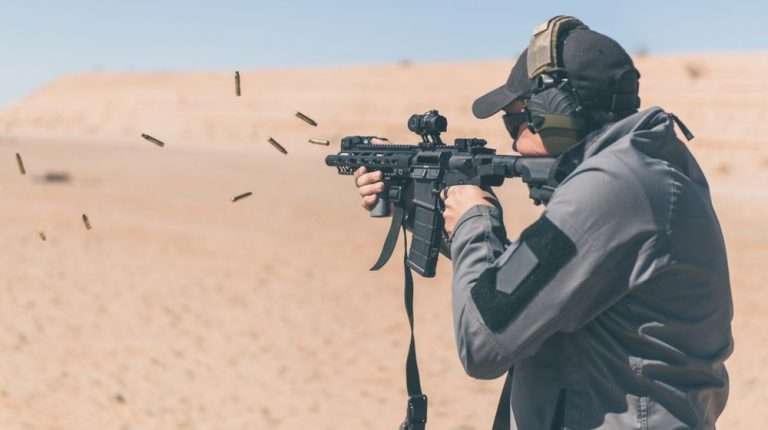
These fundamentals are the foundation of shooting. So even if you have the hardest-kicking rounds and the best rifle scope but you don’t know the basics, your shooting skills won’t improve. Here are the things to remember every time you shoot.
- Steady Position – Position yourself with your weight forward. Make sure your stance will help you manage recoil.
- Grip – Whether you’re holding a handgun or a long gun, your grip plays a big role in managing recoil. You should have a firm but not strained hold. This will also prevent limp wristing.
- Aiming – Aiming takes more than just pointing your gun at the target. It also means you have to know your sights or scope well and you know how to sight it in properly.
- Breath Control – Breathing does a lot to help you focus, so breathe and relax before every shot.
- Trigger Squeeze – Trigger control is crucial because pulling it too hard may affect your scope’s alignment or the sight picture. So it’s important to focus on applying pressure rearward, regardless if you do it fast or slow.
How to Sight In a Rifle Scope
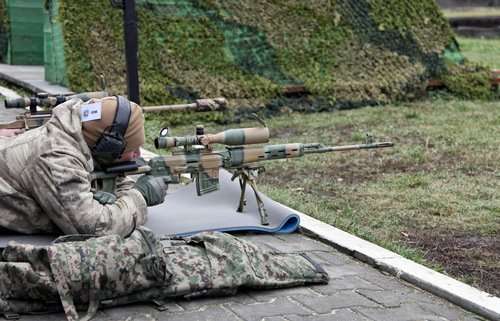
Riflescopes are every shooter’s best friend. They play a big role in improving your accuracy. And knowing how to sight them in is key. Here’s how to do it properly.
- Know your starting range
- Boresight your weapon to get the aim close
- Fire your first group
- Adjust the scope so the center of the group matches the point of aim
- Repeat until you achieve your desired accuracy
If you haven’t decided on which is better between a MilDot vs MOA scope, our complete guide should help.
It’s also critical that your scope has enough eye relief. Learn all about eye relief and its importance from this article – What is Scope Eye Relief?
Gun and Shooting Essentials
Now let’s get to the tools and equipment you’d need to invest in to make the most out of every shooting (or hunting) session.
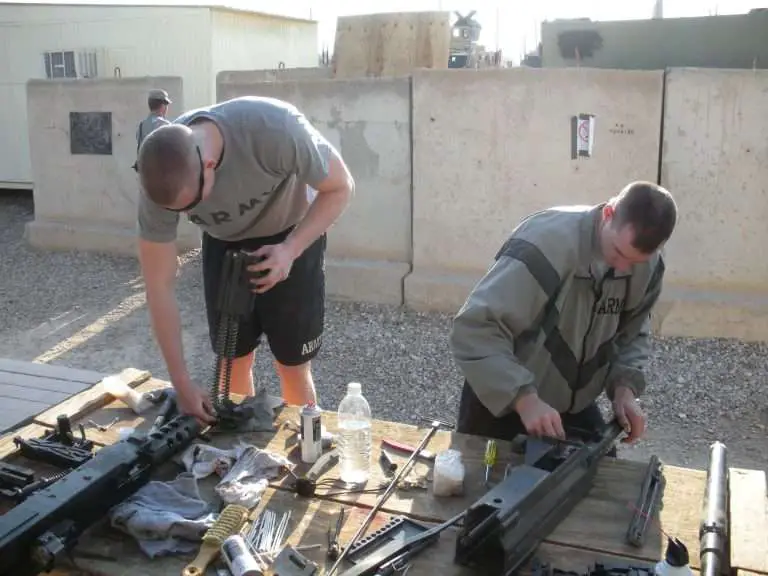
Basic Shooting Equipment and Accessories
Shooting Optics
As we mentioned earlier, optics aid in increasing your accuracy. So it’s critical to choose the best in terms of performance, durability, and reliability. There are two types of optics, scopes and red dot sights. Check out the difference below.
Scopes
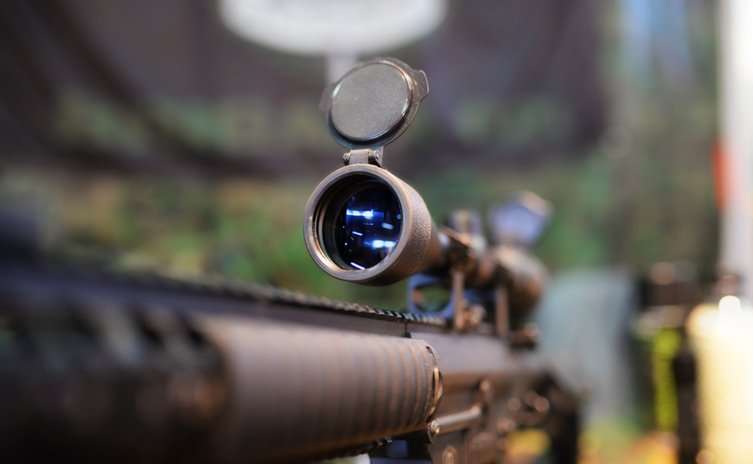
Scopes give you an edge at long distances, a longer range, better accuracy, and versatility in whatever shooting applications you intend to use them.
Want a refresher on long-range shooting or just looking for the latest gear on long-range shooting? Check out our article about the best long-range shooting blogs!
Red Dot Sights
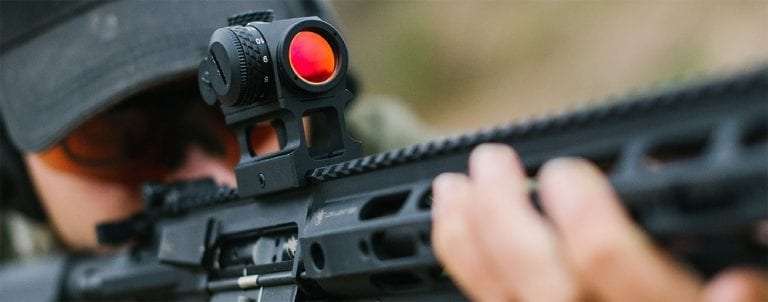
Unlike scopes, red dot sights don’t have magnifying properties. But they come in a variety of sizes so they can fit almost any firearm. They also offer faster target acquisition and work best on close to moderate shooting ranges. Learn how to sight in a red dot sight quickly here.
Some hunters prefer suppressing their guns as it gives them an advantage in stalking their game.
Bipods
If you’re really into learning long-range shooting, a quality bipod is a must-have to add stability for precision shooting. Whether you’re doing PRS matches or just enjoy long-range shooting, you’ll want a high-quality rest, and a bipod goes a long way towards that.
Suppressors
This is a great way to do more shooting with less noise. If you can shoot subsonic ammo along with a suppressor, you’ve hit the utopia of unprotected ears when shooting!
Gun Upgrades
The big explosion in the gun world over the last 10 years or so is the ability to customize your weapon. From the AR-15 to many of Glock’s patents going out of protection, the hobby of upgrading and customizing weapons has really exploded along with available 3rd party gun accessories.
- Best AR-15 Pistol Grips
- Best Left-Handed AR-15 Uppers
- Best Night Vision Binoculars
- Best 6.8 SPC Magazine
- Best Airsoft Goggles
Gun Maintenance and Cleaning
How to Clean Your Gun
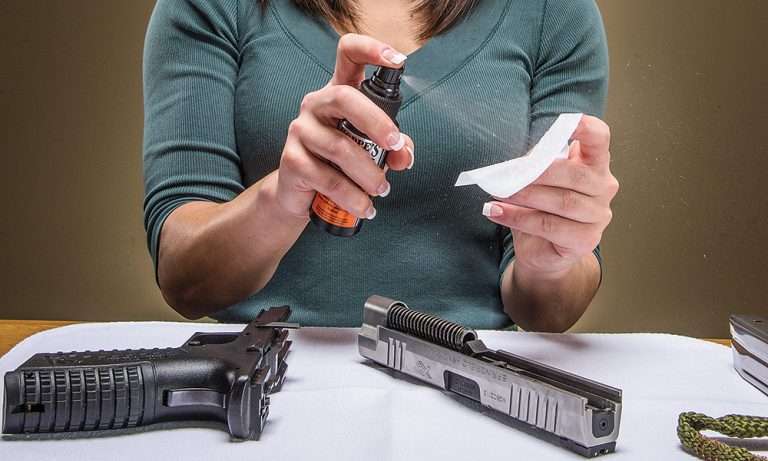
Cleaning your gun regularly is as important as learning how to shoot. Here are easy steps to giving your dismantled gun a quick clean.
- Dip your copper brush into the cleaning solvent, brush it inside your gun’s barrel and let it sit for a few minutes.
- Use a cleaning cloth or any clean rag to wipe off as much dirt as possible from your gun’s frame. After that, you can apply solvent to the frame to remove stubborn dirt and completely clean it up.
- When cleaning your gun’s rail, it’s best to use cleaning rods or Q-tips. This helps you clean your gun’s nook and crannies.
- You can wipe the magazine using a dry, clean cloth. No need to apply oil on the magazine as its residue will only collect dust and grit.
- Once you’re done with the rail, you can wipe off the solvent from the bore using a solvent-dipped wire brush or bore snake. Stubborn debris can’t be completely removed in one swipe, so you’d need to give it a pass a few times. Look into the chamber after a few swipes to check if it’s completely clean. Also, clean off the outside of the barrel thoroughly but gently using a dry rag or cleaning patches for the crevices.
- Finally, apply lubricant to the shiny parts of the frame, barrel, and recoil spring. For a more controlled and less messy application, we recommend using a Q-tip. Then give your gun a final wipe with a clean rag or an old shirt.
- To make sure that everything is working fine, reassemble and run your gun a few times.
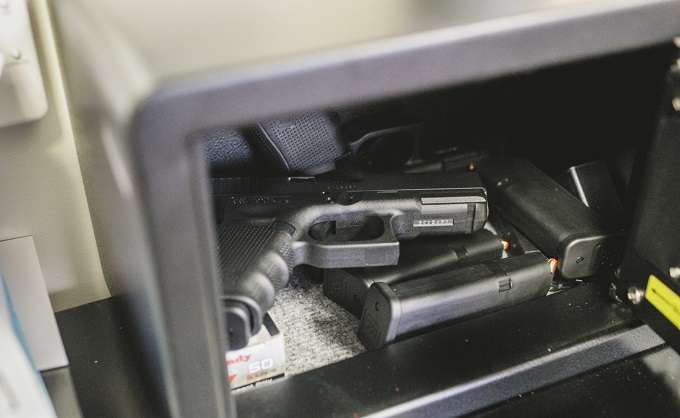
If you don’t use your guns often, you should keep them in a reliable and moisture-free safe. But keep in mind that stored firearms should be cleaned once or twice a year, as they can still collect dust and moisture over time.
Cleaning Equipment and Supplies
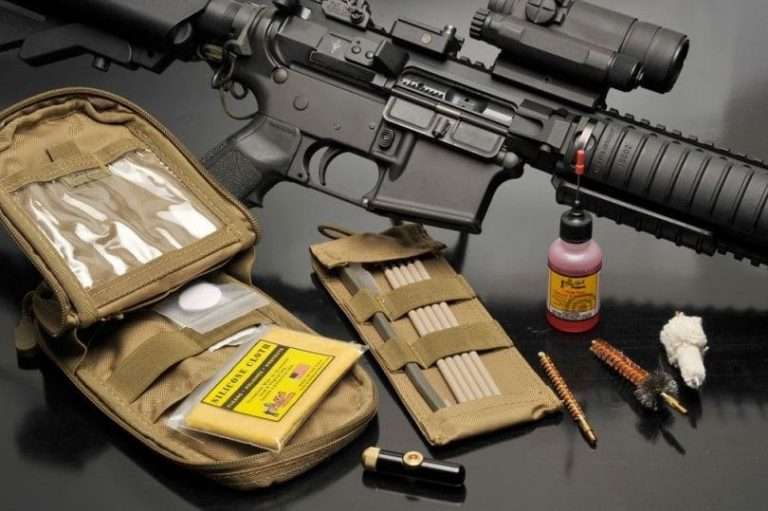
We can’t imagine how hard it was to clean firearms back in the day. Thankfully, manufacturers these days produce the most effective and reliable cleaning equipment and supplies for guns; making everything a lot easier for us gun enthusiasts. It’s important to use the right gun cleaning kit and the proper cleaning solvent, as our gun’s life depends on it. Here’s a list of other gun cleaning supplies that you should consider buying;
- Bore snake
- Gun cleaning mat
- Gun vise
- Gun cleaning oil
- Pistol cleaning kit
- Shotgun cleaning kit
- Rifle cleaning kit
Ammo Storage Containers
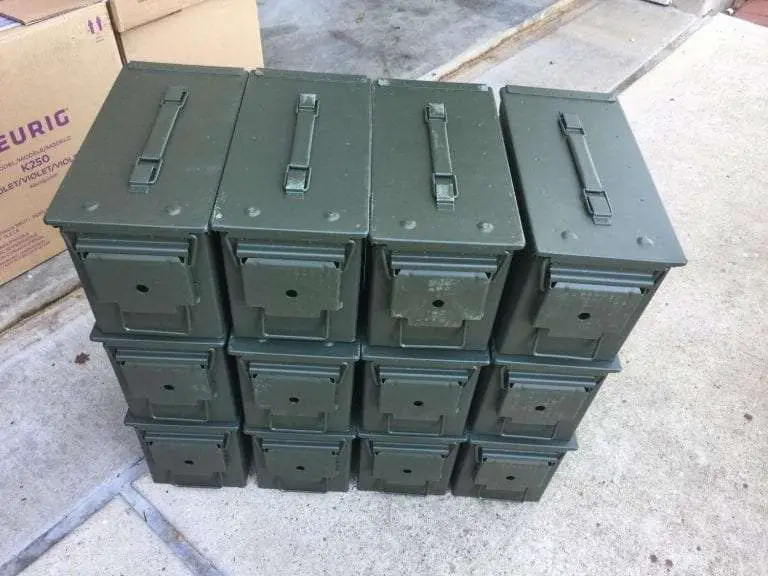
If you haven’t thought this far, now’s the time to decide which ammo storage containers you’ll be getting. These containers won’t only keep your ammunition safe and organized, but they will also keep them dry. The best ammo storage containers keep your ammunition away from any contaminants that may cause corrosion and rust.
Gun Storage
You won’t always have your gun with you. So whether you’re gonna leave it in your house or in your car, adhere to the best ways to store guns.
Safes
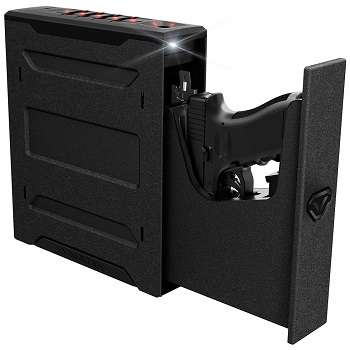
A gun safe is your best option if you want to keep your firearms secured and away from moisture. You can choose a small safe for portability or a sturdier one that can be mounted on your wall or inside your walk-in closet. You can also use these safes to store your other valuables like cash and jewelry.
Biometric Gun Safe
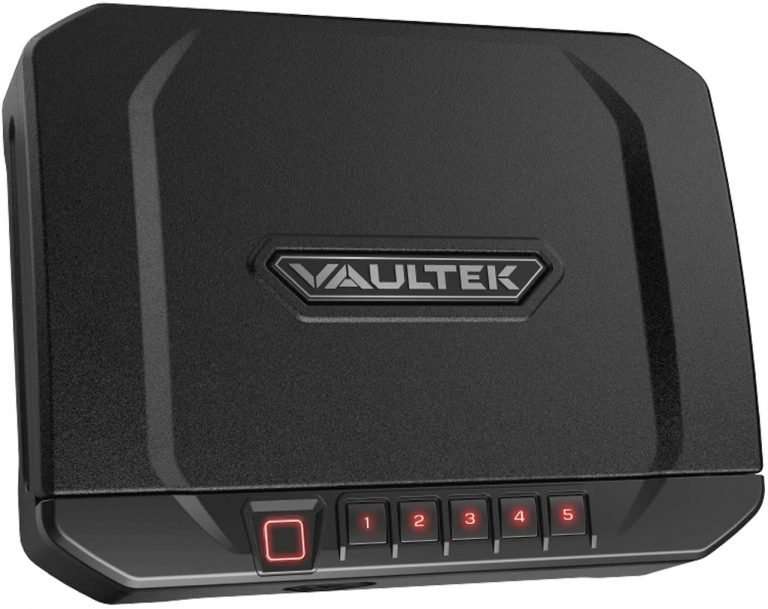
What’s great about biometric gun safes is that they’re very secure, especially those top-tier models. With these safes, you can only open the safe with your fingerprint, so thieves can’t open them easily. Unless of course, they use heavy machinery and tools. Some biometric pistol safes can also be opened via key, so you’ll have a backup during power outages.
Fireproof Gun Safe
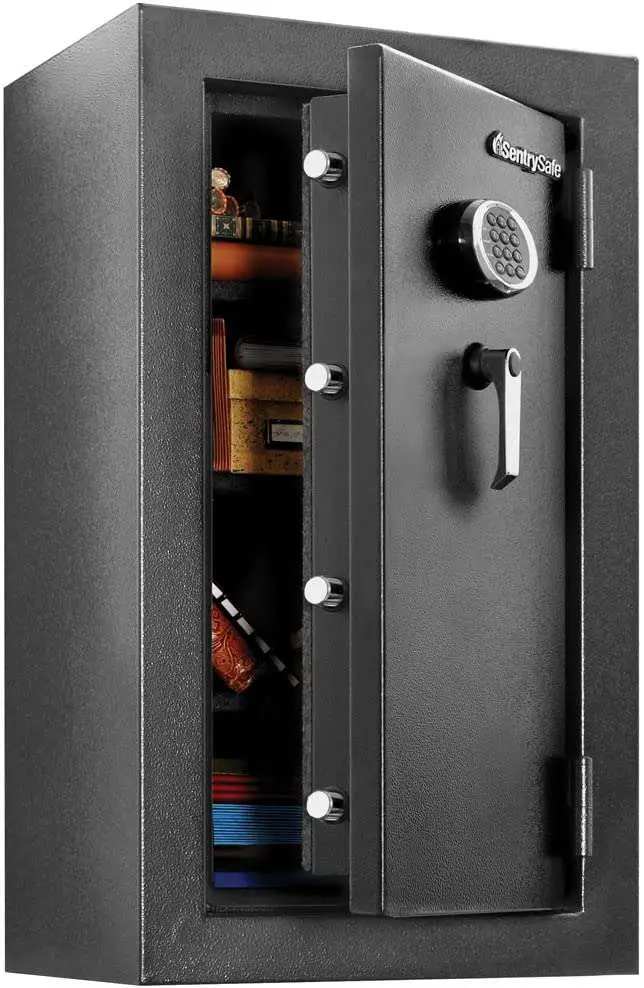
Fires break out when you least expect them, so if you’ve extra money to spend, it’s best to get a fireproof gun safe.
Bags
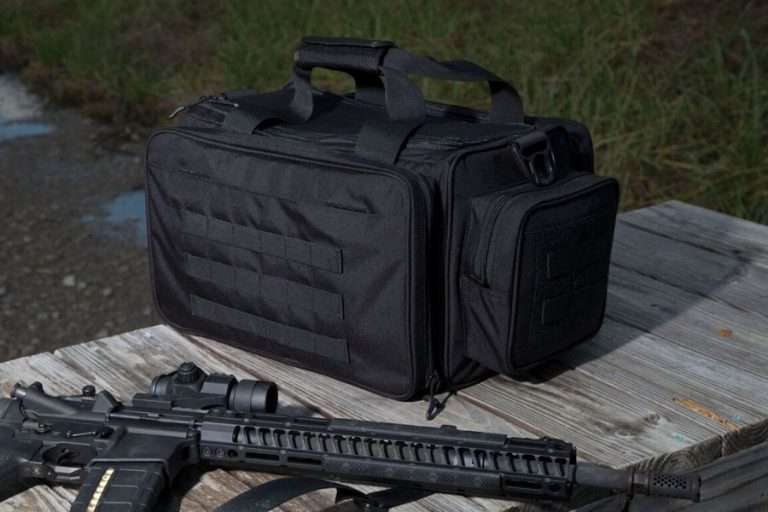
Another essential that you need to invest in is a range bag. The most important thing to consider when choosing one is its durability and safety features. Aside from keeping your gun secured, it should also be able to accommodate all your shooting equipment, including your ammo and your cleaning kit (if you like giving your gun a quick clean after shooting).
Where to Shoot
Indoor vs. Outdoor Shooting Range
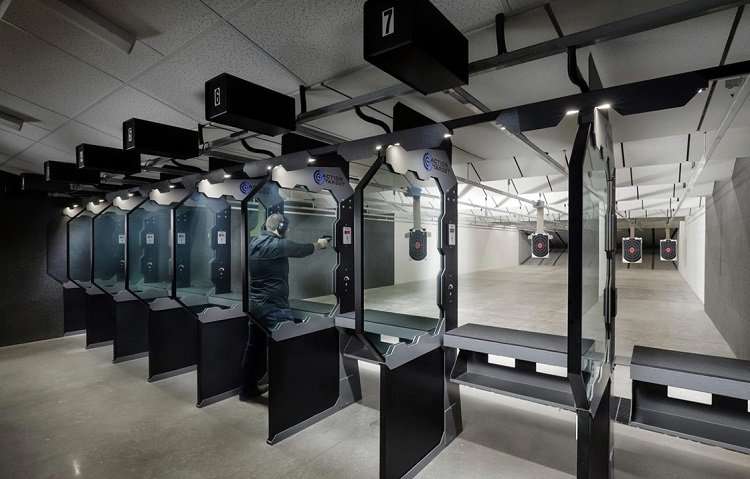
Indoor shooting ranges and outdoor shooting ranges have their pros and cons. Indoor shooting ranges are more accessible and climate-controlled while outdoor shooting ranges are often more flexible about shooting setups and allowed weapons. But at the end of the day, it all depends on you, shoot where you’re most comfortable. Aside from comfort, there are other things to consider such as cost and safety. Check out our detailed comparison of indoor vs outdoor shooting ranges here.
Love the firearm-related contents in Reddit? Check out our list of the best subreddits for gun lovers!
Advanced Topics
Self-Defense
Most people buy guns for self-defense or for home protection, and we’re sure one of those are the reasons why you want to get a gun. If that’s the case, you’ll be needing more than a firearm. To protect yourself and your loved ones properly, you also need basic knowledge of self-defense techniques and how to apply them in real life.
Further reading:
- Guns used by John Wick
- Guns used by John Wick 2
- Guns used by John Wick 3
- Guns used in John Wick 4
- Guns used by SEALs
- Guns used by Special Forces
Concealed Carry Fundamentals
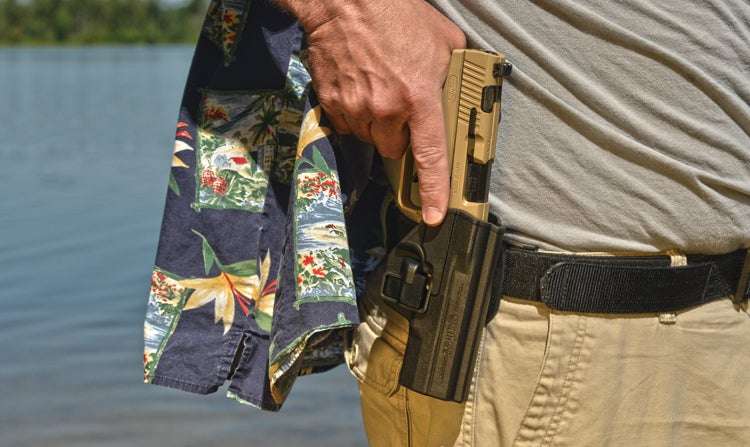
Choosing the right holster or concealed carry purse is the first step to concealing your handgun properly. There are plenty of holster types, belly band, shoulder, ankle holsters, and even pocket holsters. If you need help deciding which holster is right for you, we got you! Here’s an extensive list of our best holsters reviews:
Looking for the best single-stack 9mm for your concealed carry? Check out our S&W Shield 2.0 review! But if you prefer a classic, you’ll love our FN High Power review.
Reloading Ammo
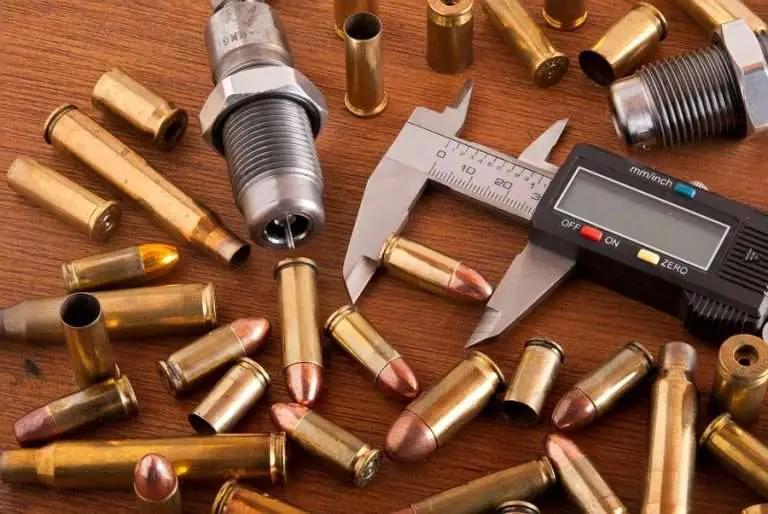
Recreational shooting is not a cheap hobby, so reloading your ammunition is one way to save money. Plus it allows you to produce unique and more consistent rounds.
Reloading ammo also requires several tools, such as a brass catcher, a reloading press, a case trimmer, and a brass tumbler. It may seem like a lot of purchases, but buying equipment for reloading helps you be more autonomous, gives you the flexibility to explore loads for greater accuracy than you can get otherwise, and can be a way to save money.
It’s also important to familiarize yourself with the most commonly used cartridges. Interested? Our ultimate rifle caliber comparison is a great place to start. You can also use the best shooting chronograph to test your loads’ ballistics so you know which areas need improvement.
Hunting
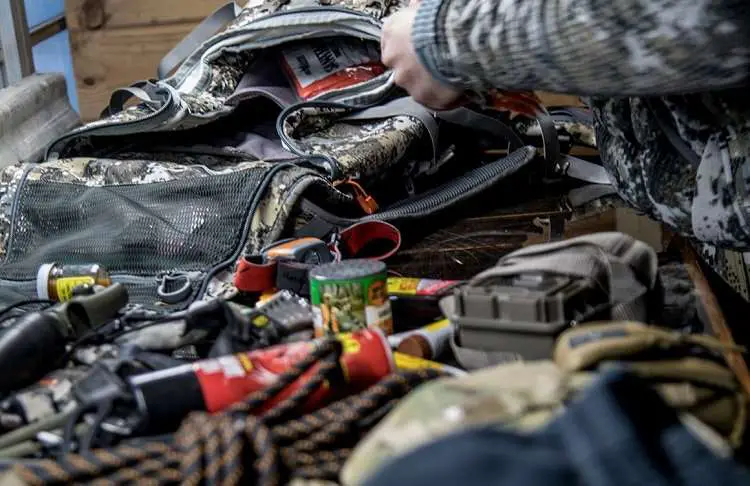
Hunting is one of the sports that you can enjoy once you’ve become a skilled shooter. If you’re not that experienced yet, it’s definitely fine. Hunting is enjoyable even for beginners, just ask around and I’m sure you’ll find someone who will be happy to mentor you.
Aside from experience, a pair of binoculars, a hunting tree stand, and a rangefinder can help you catch your quarry.
Looking for the best rifle for hunting? Check out our review of the best 30-06 rifle.
Conclusion
You can apply these shooting techniques as soon as you get to the range, but don’t expect to be an expert at once! Learning how to shoot accurately takes lots of patience and practice, and the proper tools, of course! The most important thing is, that you’ve learned how to take care of your gun and ammo properly, as this is one of the first steps in becoming a smart shooter.
Now that you know the basics, learn more about shooting tactics in our article about the best shooting tactics blogs!
Are you a competitive shooter looking to join a 3-gun competition? We put together an article where you can find the best 3-gun competition blogs!
Interested in joining the military? Learn about the US military creeds first!
Wondering what gifts gun enthusiasts would love? These articles should help:
